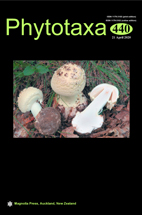Abstract
During a biodiversity survey of Alternaria associated with leaf spot and blight of Solanaceae, a large collection of strains was obtained from samples collected in north-western regions of Algeria in 2013–2018 growing seasons. Amongst these strains, three isolates recovered from tomato and potato had morphological traits different from that usually observed for Alternaria species previously reported on Solanaceae. Based on analysis of a sequence dataset corresponding to portions of the glyceraldehyde-3-phosphate dehydrogenase (gpd), translation elongation factor 1-alpha (tef1) and RNA polymerase second largest subunit (rpb2) genes along with morphological observations, isolates were identified as a new species in the section Japonicae. This novel species, described here as Alternaria telliensis, is phylogenetically and morphologically distinct from A. japonica and A. nepalensis in this section. Pathogenicity tests were performed and isolates were found to be weakly pathogenic to tomato and potato (Solanaceae) while highly aggressive on radish, cabbage and turnip (Brassicaceae) plants.

